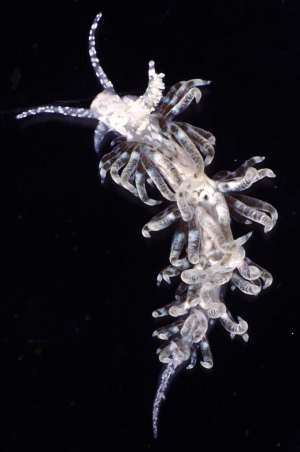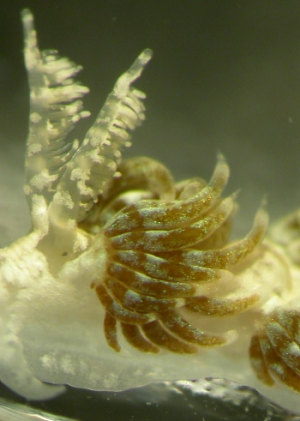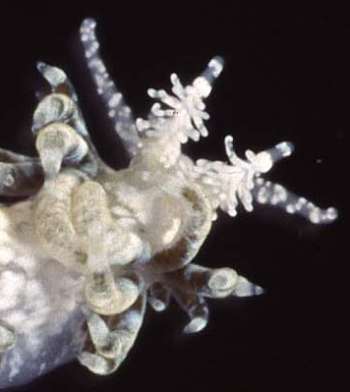
Palisa sp. 1
Order: NUDIBRANCHIA
Suborder: AEOLIDINA
Family: Glaucidae
PHOTO
Heron Island, Great Barrier Reef, Queensland, Australia. Pacific Ocean. Depth: Intertidal. Length: 9 mm. 16 March 2005. Intertidal. Photographer: Julie Marshall
Palisa Edmunds (1964) seems to be a problematical genus based on one or perhaps two Caribbean species, Palisa papillata Edmunds, 1964 and P. kristenseni (Marcus & Marcus, 1963). Edmunds noted tuberculate rhinophores, radular teeth lacking a prominent cusp, and details of the reproductive system as important but was not sure which charcters would turn out to be of generic importance, and which characters would be just of specific value. Later (Edmunds & Just, 1983) placed Moridilla kristenseni Marcus & Marcus in Palisa and decided it was a senior synonym of Palisa papillata, which means we still have problems in defining Palisa. Certainly your animal has tuberculate rhinophores and appears to have the cerata arranged in arches, so it is possible it is a species of Palisa, but we would need to have a look at its anatomy to confirm it.
-
Edmunds, M. (1964) Eolid mollusca from Jamaica, with descriptions of two new genera and three new species. Bulletin of Marine Science of the Gulf and Caribbean, 14: 1-32.
-
Edmunds, M & Just, H (1983) Eolid nudibranchiate Mollusca from Barbados. Journal of Molluscan Studies, 49(3): 185-203.
-
Marcus, Ev. & Marcus, Er. (1963) Opisthobranchs from the Lesser Antilles. Studies on the Fauna of Curacao and other Caribbean Islands, 19(79): 1-76.
Rudman, W.B., 2005 (April 20) Palisa sp. 1 [In] Sea Slug Forum. Australian Museum, Sydney. Available from http://www.seaslugforum.net/find/palisp1
Related messages
Palisa sp. from Lizard Island, Australia
January 9, 2007
From: Nils Anthes


Concerning message #13531:
Dear Bill and Julie,
I just happened to bump into Julie Marshall's pictures of Palisa sp. from Heron Island, realising that we have found presumably the same species previously on Lizard Island. I attach some pictures, showing both the whole animal as well as details of the rhinophores with the distinct papillae on the posterior side. Even more pronounced, the cerata are arranged in distinct arches The animal was sitting in dense algal mats on sandy Casuarina Beach.
Locality: Lizard Island, Great Barrier Reef, 3m, Queensland, Australia, Pacific Ocean, 18 December 2003, algae on sand. Length: 7mm. Photographer: Nils Anthes.
There is a photo of it as 'Aeolid sp'. in:
-
Wägele, H., I. Burghardt, N. Anthes, J. Evertsen, A. Klussmann-Kolb & G. Brodie (2006): Species diversity of Opisthobranch Molluscs from Lizard Island, Great Barrier Reef, Australia. Records of the Western Australian Museum, Suppl. 69: 33-60.
Regards
Nils
nils.anthes@uni-tuebingen.de
Anthes, N., 2007 (Jan 9) Palisa sp. from Lizard Island, Australia. [Message in] Sea Slug Forum. Australian Museum, Sydney. Available from http://www.seaslugforum.net/find/19157
Thanks Nils,
Bill Rudman
Palisa sp. from Heron Island
April 21, 2005
From: Julie Marshall


Dear Bill,
Here are photos of another species which Bob Burn found whilst sieving alga (and obviously some hydroids) attached to coral clumps on the reef flat at Heron Island [Great Barrier Reef] at low tide when he was with me there in March.
The photos with this message are of what we consider to be a species of Palisa. It was 9 mm and is distinguished by the large rhinophores, which have ten rows of long papillae on their posterior side, and by the slender and curved cerata. The general body colour was translucent white with opaque white blotches all over, and these are repeated on the head and the rhinophores. The oral tentacles are alternately translucent and opaque white. The cerata are dark brown due to the digestive gland with bluish-white and opaque white patches.
Locality: Heron Island, Great Barrier Reef, Queensland, Australia. Pacific Ocean. Depth: Intertidal. Length: 9 mm. 16 March 2005. Intertidal. Photographer: Julie Marshall
Best wishes,
Julie Marshall
juliemarshall@netspace.net.au
Marshall, J.G., 2005 (Apr 21) Palisa sp. from Heron Island. [Message in] Sea Slug Forum. Australian Museum, Sydney. Available from http://www.seaslugforum.net/find/13531
Thanks Julie,
Palisa Edmunds (1964) seems to be a problematical genus based on one or perhaps two Caribbean species, Palisa papillata Edmunds, 1964 and P. kristenseni (Marcus & Marcus, 1963). Edmunds noted tuberculate rhinophores, radular teeth lacking a prominent cusp, and details of the reproductive system as important but was not sure which charcters would turn out to be of generic importance, and which characters would be just of specific value. Later (Edmunds & Just, 1983) placed Moridilla kristenseni Marcus & Marcus in Palisa and decided it was a senior synonym of Palisa papillata, which means we still have problems in defining Palisa. Certainly your animal has tuberculate rhinophores and appears to have the cerata arranged in arches, so it is possible it is a species of Palisa, but we would need to have a look at its anatomy to confirm it.
-
Edmunds, M. (1964) Eolid mollusca from Jamaica, with descriptions of two new genera and three new species. Bulletin of Marine Science of the Gulf and Caribbean, 14: 1-32.
-
Edmunds, M & Just, H (1983) Eolid nudibranchiate Mollusca from Barbados. Journal of Molluscan Studies, 49(3): 185-203.
-
Marcus, Ev. & Marcus, Er. (1963) Opisthobranchs from the Lesser Antilles. Studies on the Fauna of Curacao and other Caribbean Islands, 19(79): 1-76.
Bill Rudman Rudman, W.B., 2005 (Apr 21). Comment on Palisa sp. from Heron Island by Julie Marshall. [Message in] Sea Slug Forum. Australian Museum, Sydney. Available from http://www.seaslugforum.net/find/13531
